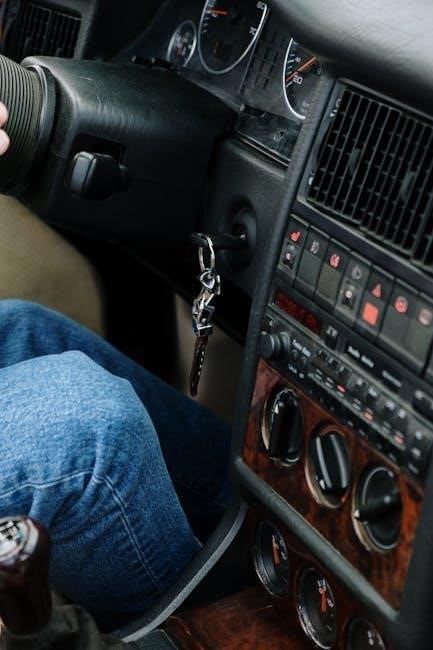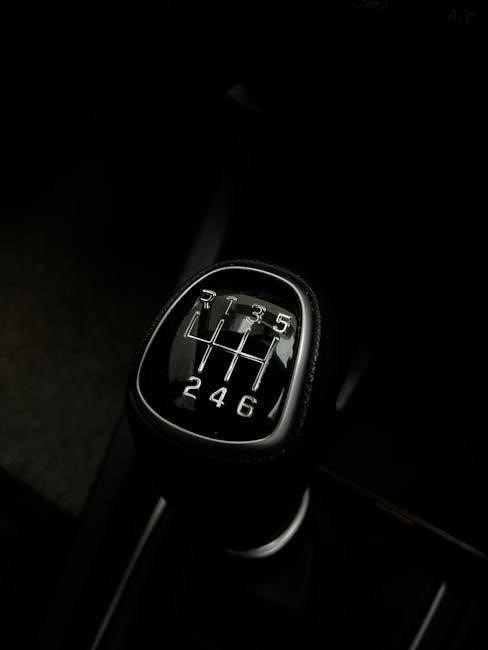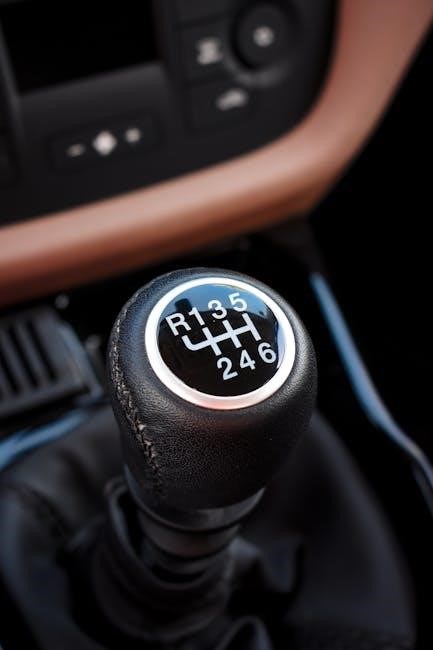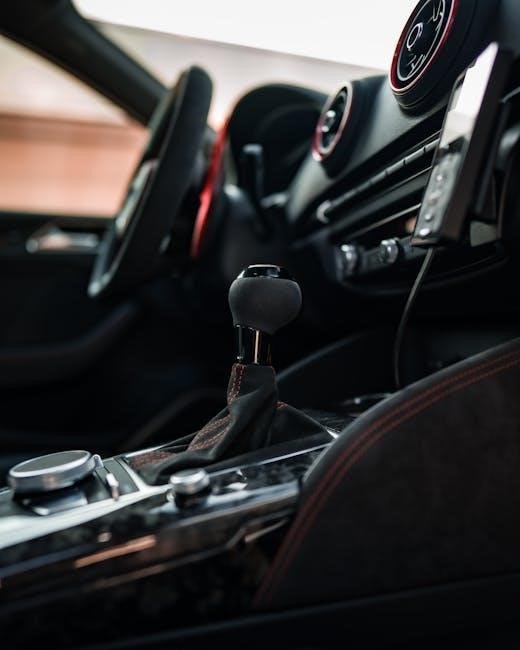What is a Manual Shift Linkage?
A manual shift linkage is a mechanical system connecting the gearshift to the transmission, enabling drivers to manually change gears. It includes key components like the gearshift, shift rod, and coupler, ensuring precise gear engagement and smooth operation.
1.1 Definition and Purpose
A manual shift linkage is a mechanical system designed to connect the gearshift lever directly to the transmission, allowing drivers to manually select and engage gears. Its primary purpose is to transmit the driver’s gear selection input to the transmission, ensuring smooth and precise gear changes. The linkage plays a crucial role in synchronizing the movement of the gearshift with the transmission’s internal mechanisms, enabling efficient power delivery and control over the vehicle’s speed and torque. By providing a direct connection between the driver and the transmission, the manual shift linkage enhances driver control and overall vehicle performance, making it an essential component of manual transmissions.
1.2 Key Components of a Manual Shift Linkage
The manual shift linkage consists of several critical components that work together to facilitate gear changes. The gearshift, typically located on the center console or steering column, is the input point for the driver. Connected to it is the shift rod, a sturdy metal rod that transmits the driver’s movements to the transmission. At the transmission end, the coupler attaches the shift rod to the gear selector fork, which engages the desired gear. Additionally, bushings and bearings are used to reduce friction and ensure smooth operation. These components are essential for precise and efficient gear engagement, allowing the driver to maintain control over the vehicle’s speed and torque.

Components of a Manual Shift Linkage
The manual shift linkage includes key components like the gearshift, shift rod, and coupler, which work together to transmit gear selections to the transmission.
2.1 Gearshift
The gearshift, located inside the vehicle, is the driver’s interface for selecting gears. It connects to the shift rod, translating the driver’s movements into gear changes. Proper alignment and lubrication ensure smooth operation, while wear can cause misalignment or difficult shifting. The gearshift’s design varies, from manual to automatic, each requiring specific maintenance to function optimally.
2.2 Shift Rod
The shift rod is a critical component of the manual shift linkage, directly connecting the gearshift to the transmission. Its primary function is to transfer the driver’s gear selection inputs to the transmission, ensuring precise engagement of the desired gear. Typically constructed from durable materials like steel or aluminum, the shift rod is designed to withstand the mechanical stresses of frequent gear changes. Over time, wear and tear can cause the shift rod to become loose or misaligned, leading to difficulties in shifting gears smoothly. Proper alignment and regular maintenance are essential to maintain optimal performance and prevent potential issues with gear engagement.
2.3 Coupler
The coupler is a vital connector within the manual shift linkage, linking the shift rod to the transmission’s gear selector fork. It ensures smooth, accurate gear transitions by maintaining a secure connection between these components. The coupler is typically designed with a universal joint or bushing, allowing for some flexibility and movement during gear shifts. Over time, wear on the coupler can lead to play in the system, causing vague or imprecise gear engagement. Regular inspection and replacement of worn couplers are crucial to maintaining the overall efficiency and responsiveness of the manual shift linkage, ensuring a smooth driving experience.
How a Manual Shift Linkage Works
The manual shift linkage transmits the driver’s gearshift movements to the transmission, enabling precise gear engagement through mechanical connections and synchronization of shifting components.
3.1 Mechanical Advantage and Gear Engagement

The manual shift linkage provides mechanical advantage by translating the driver’s gearshift movements into precise gear engagement. As the driver moves the gearshift, the shift rod and coupler transmit this motion to the transmission. The system ensures smooth synchronization, allowing gears to mesh properly without grinding. This mechanical connection maintains optimal alignment, preventing misengagement and wear on transmission components. The linkage’s design minimizes effort required for shifting while maximizing control, ensuring efficient and reliable gear changes. Proper mechanical advantage and synchronization are critical for seamless operation, making manual shifting both intuitive and effective.
3.2 Synchronization of Shift Components
The synchronization of shift components ensures that the gearshift, shift rod, and coupler work in harmony. When the driver moves the gearshift, the shift rod transmits this motion to the transmission, aligning the coupler with the desired gear. Proper synchronization prevents misalignment, which can cause gears to grind or fail to engage. This alignment ensures smooth transitions between gears, reducing wear on the transmission and enhancing the driving experience; Regular maintenance of these components is crucial to maintain synchronization and prevent operational issues, ensuring the manual shift linkage functions as intended for optimal vehicle performance and driver control.


Common Issues with Manual Shift Linkage
Common issues include worn bushings, misalignment, and looseness, leading to gear engagement problems. These issues can cause difficulty shifting and transmission damage if left unaddressed.

4.1 Worn Bushings and Bearings
Worn bushings and bearings are common issues in manual shift linkages. Over time, these components can deteriorate due to friction and wear, leading to loose connections and misalignment. This wear can cause the gearshift to feel sloppy or difficult to engage, making it hard to shift gears smoothly. If left unaddressed, worn bushings and bearings can result in further damage to the transmission and related components. Regular maintenance and inspection are crucial to identify and replace worn parts before they cause more severe problems. Replacing these components early can help maintain smooth gear shifting and prevent costly repairs down the line.
4.2 Misalignment or Looseness
Misalignment or looseness in the manual shift linkage can disrupt smooth gear transitions. This issue often arises from improper installation, wear and tear, or accidental damage. When components are misaligned, the gearshift may feel vague or unresponsive, leading to difficulty in engaging gears properly. Looseness can cause the linkage to move excessively, resulting in inconsistent or partial gear engagement. Over time, this can lead to premature wear on other transmission parts. Addressing misalignment or looseness promptly is crucial to maintain precise control over gear shifts and prevent further damage to the transmission system. Proper adjustment or tightening of the linkage can often resolve these issues effectively.

Diagnosis and Repair
Diagnosing manual shift linkage issues involves inspecting for worn parts and testing gear engagement. Repairs often require replacing damaged components or adjusting the linkage for proper alignment and function.
5.1 Identifying Faults
Identifying faults in a manual shift linkage involves observing symptoms like difficulty shifting gears, grinding noises, or loose movement. Inspecting the gearshift, shift rod, and coupler for wear or misalignment is crucial. A common issue is worn bushings, which can cause vibration and imprecise gear engagement. Additionally, a friend can move the gearshift while observing the linkage for excessive play or movement, indicating potential misalignment. Regular lubrication and checking for loose connections can prevent major repairs. Addressing these issues early ensures smooth transmission operation and avoids further damage to the system.
5.2 Replacement and Adjustment
Replacing or adjusting a manual shift linkage involves removing the faulty components and installing new ones. Start by disconnecting the shift rod from the transmission and removing the gearshift assembly. Inspect and replace worn bushings, bearings, or couplers with OEM or high-quality aftermarket parts. Proper alignment is crucial to ensure smooth gear engagement. Tighten all connections securely but avoid overtightening, which can restrict movement. Apply a thin layer of grease to moving parts for lubrication. Adjust the shift linkage according to the manufacturer’s specifications to restore precise shifting. Regular maintenance and timely repairs prevent further damage and ensure optimal performance of the manual transmission system.